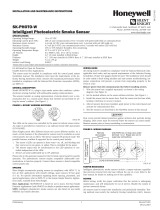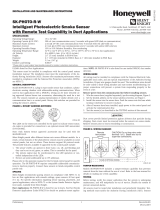Page is loading ...

This sensor must be installed in compliance with the control panel system
installation manual and the SWIFT Wireless Manual. The installation must
meet the requirements of the Authority Having Jurisdiction (AHJ). Sensors
offer maximum performance when installed in compliance with the National
Fire Protection Association (NFPA); see NFPA 72.
GENERAL DESCRIPTION
Model WSK-PHOTO and WSK-PHOTO-T are plug-in type smoke sensors that
combine a photoelectronic sensing chamber with wireless communication.
The sensors transmit a digital representation of smoke density through a wire-
less mesh to a gateway. The gateway will send the information to the panel
when requested. Rotary dial switches are provided for setting the sensor’s
address. (Figure 1)
Two LEDs on the sensor are controlled by the panel to indicate sensor status.
Model WSK-PHOTO-T combines a photoelectronic sensing chamber and 135°F
(57.2°C) fixed temperature heat detector.
Silent Knight panels offer different features sets across different models. As a
result, certain features of the WSK-PHOTO and WSK-PHOTO-T may be avail-
able on some control panels, but not on others. The possible features available
in the WSK-PHOTO and WSK-PHOTO-T, if supported by the control panel are:
• The panel controls the LED operation on the sensor. Operational modes
include red, green and amber colors in various solid or blink patterns.
Please refer to the operation manual for the UL listed control panel for specific
operation of the WSK-PHOTO and WSK-PHOTO-T.
The WSK-PHOTO and WSK-PHOTO-T require compatible addressable com-
munications to function properly. Connect these sensors to listed-compatible
control panels only.
SPACING
Silent Knight recommends spacing sensors in compliance with NFPA 72. In
low air flow applications with smooth ceilings, space sensors 30 feet apart.
For specific information regarding sensor spacing, placement, and special ap-
plications, refer to NFPA 72 or the System Smoke Detector Application Guide,
available from SystemSensor.com.
Wireless technologies can exhibit communication disruption if devices are
spaced too close together. To avoid this form of disruption, SWIFT devices
should not be placed closer than 2 feet (60 cm) apart without an intervening
structure.
NOTE: Do not attach the base and detectors to temporary structures such as
removable ceiling tiles such that the placement could be altered. To prevent
changes in device placement, permanently secure the structure or mount the
detector across the ceiling panel support as shown in Figure 2.
SPECIFICATIONS
Operating Voltage Range: 3.3 VDC
Standby Current: 210µA @ 3.3 VDC (one communication every 23.8 seconds with LED blink enabled)
Maximum Alarm Current (LED on): 5 mA @ 3.3 VDC LED on
Maximum Transmit RF Power: 17dBm
Radio Frequency Range: 902-928 MHz
Operating Humidity Range: 10% to 93% Relative Humidity, Non-condensing
Operating Temperature Range: 32°F to 120°F (0°C to 49°C),WSK-PHOTO; 32°F to 100°F (0°C to 38°C),WSK-PHOTO-T
Battery Type: 4 Panasonic CR123A or 4 Duracell DL123A
Battery Life: 2 year minimum
Battery Replacement: Upon TROUBLE BATTERY LOW display and/or during annual maintenance
Height: 2.4in. (61 mm) installed in B501W Base
Diameter: 4.0in. (102 mm) installed in B501W Base
Weight: 8.1 oz. (230 g) installed in B501W base with 4 batteries
BATTERY REPLACEMENT
Low battery levels on the wireless devices are displayed as a trouble on the
FACP. Therefore when the message “TROUBLE BATTERY LOW” is displayed,
replace the battery in the device. This message is an indication that approxi-
mately one week of battery life remains.
To replace the batteries in a wireless device use the following steps:
1. Have 4 CR123A (or DL123A) batteries available
2. Remove the detector from the base.
3. Open the battery compartment refer to Figure 3. Note: The battery compart-
ment cover may be left attached at the hinges during battery replacement.
4. Remove the used batteries and replace with new batteries. The battery
compartment is designed such that the batteries can only align in the ap-
propriate direction. Do not force the batteries into the openings.
5. Replace the battery compartment cover.
6. Return the device to its original location.
TENS ONES
9
10
11
12
13
14
15
8
7
6
5
4
3
2
1
0
9
8
7
6
5
4
3
2
1
0
C0162-00
FIGURE 1. ROTARY ADDRESS SWITCHES:
I56-4269-000
INSTALLATION AND MAINTENANCE INSTRUCTIONS
12 Clintonville Road, Northford, CT 06472-1610
Phone: 203-484-7161 Fax: 203-484-7118
www.silentknight.com
WSK-PHOTO & WSK-PHOTO-T
Wireless Intelligent
Photoelectric Smoke Sensor
1 I56-4269-000
03-02

apply aerosol until the panel alarms.
Additionally, canned aerosol simulated smoke (canned smoke agent)
may be used for smoke entry testing of the smoke detector. Tested and
approved aerosol smoke products are:
MANUFACTURER MODEL
Home Safeguard Industries 25S and 30S
SDi CHEK02 and CHEK06
SDi SOLOA4
SDi SMOKESABRE-01
When used properly, the canned smoke agent will cause the smoke detector
to go into alarm. Refer to the manufacturer’s published instructions for proper
use of the canned smoke agent.
CAUTION
Canned aerosol simulated smoke (canned smoke agent) formulas will vary by
manufacturer. Misuse or overuse of these products may have long term ad-
verse effects on the smoke detector. Consult the canned smoke agent manufac-
turer’s published instructions for any further warnings or caution statements.
C. Direct Heat Method (Hair dryer of 1000-1500 watts).
A hair dryer of 1000-1500 watts should be used to test the thermistors. Di-
rect the heat toward either of the two thermistors, holding the heat source
approximately 12 inches from the detector in order to avoid damaging
the plastic housing. The detector will reset only after it has had sufficient
time to cool. Make sure both thermistors are tested individually.
A sensor that fails any of these tests should be cleaned as described under
CLEANING, and retested. If the sensor fails after cleaning, it must be replaced
and returned for repair.
When testing is complete, restore the system to normal operation and notify
the proper authorities that the system is back in operation.
CLEANING
Before removing the detector, notify the proper authorities that the smoke de-
tector system is undergoing maintenance and will be temporarily out of service.
Disable the zone or system undergoing maintenance to prevent unwanted alarms.
1. Remove the sensor to be cleaned from the system.
2. Remove the sensor cover by pressing firmly on each of the four removal
tabs that hold the cover in place. (refer to Figure 5).
3. Vacuum the screen carefully without removing it. If further cleaning is
required continue with Step 4, otherwise skip to Step 7.
4. Remove the chamber cover/screen assembly by pulling it straight out.
5. Use a vacuum cleaner or compressed air to remove dust and debris from
the sensing chamber.
6. Reinstall the chamber cover/screen assembly by sliding the edge over the
sensing chamber. Turn until it is firmly in place.
7. Replace the cover using the LEDs to align the cover and then gently
pushing it until it locks into place. Make sure that the thermistors do not
become bent under the cover on the WSK-PHOTO-T.
8. Reinstall the detector.
9. Test the detector as described in TESTING.
10. Reconnect disabled circuits.
11. Notify the proper authorities that the system is back on line.
SPECIAL NOTE REGARDING SMOKE DETECTOR GUARDS
Smoke detectors are not to be used with detector guards unless the combina-
tion has been evaluated and found suitable for that purpose.
BATTERY
COMPARTMENT
COVER
FIGURE 2. CEILING PANEL SUPPORT:
FIGURE 3. BATTERY COMPARTMENT:
CAUTION
Dust covers provide limited protection against airborne dust particles during
shipping. Dust covers must be removed before the sensors can sense smoke.
Remove sensors prior to heavy remodeling or construction.
TAMPER RESISTANCE
WSK-PHOTO and WSK-PHOTO-T include a tamper-resistant capability that
prevents their removal from the base without the use of a tool. Refer to the
base manual for details on making use of this capability. The base also in-
cludes a magnet for tamper resistance. The magnet activates a supervisory
tamper fault at the panel if the detector is removed from the base.
TESTING
Before testing, notify the proper authorities that the system is undergoing
maintenance, and will temporarily be out of service. Disable the system to
prevent unwanted alarms.
All sensors must be tested after installation and periodically thereafter. Testing
methods must satisfy the Authority Having Jurisdiction (AHJ). Sensors offer max-
imum performance when tested and maintained in compliance with NFPA 72.
The sensor can be tested in the following ways:
A. Functional: Magnet Test (P/N M02-04-01 or M02-09-00)
This sensor can be functionally tested with a test magnet. The test mag-
net electronically simulates smoke in the sensing chamber, as well as
tests the sensor electronics and connections to the control panel.
1. Hold the test magnet in the magnet test area as shown in Figure 4.
2. The sensor should alarm the panel.
Two LEDs on the sensor are controlled by the panel to indicate sensor
status. Coded signals, transmitted from the panel, can cause the LEDs
to blink, latch on, or latch off. Refer to the control panel technical docu-
mentation for sensor LED status operation and expected delay to alarm.
B. Smoke Entry
The GEMINI model 501 aerosol generator can be used for smoke entry
testing. Set the generator to represent 4%/ft to 5%/ft obscuration as de-
scribed in the GEMINI 501 manual. Using the bowl shaped applicator,
C2015-00
C1092-00
2 I56-4269-000
03-02

C2013-01
LED
TEST MAGNET
POSITION
MAGNET TEST
MARKER
LED
COVER
REMOVAL
TABS
SENSOR
COVER
WSK-PHOTO
WSK-PHOTO-T
SENSING CHAMBER
COVER AND SCREEN
SENSING
CHAMBER
COVER
REMOVA
L
TABS
FIGURE 5. DETECTOR COMPONENTS:
FIGURE 4. MAGNET TEST MARKERS:
C0145-02
3 I56-4269-000
03-02

Please refer to insert for the Limitations of Fire Alarm Systems
This device complies with part 15 of the FCC Rules. Operation is subject to the following two conditions:
1. This device may not cause harmful interference, and
2. This device must accept any interference received, including interference that may cause undesired operation.
WARNING: Do not make changes to the equipment. Changes or modifications not expressly approved by the manufacturer could void the user’s authority to operate the equipment.
FCC STATEMENT
Use of these products in combination with non-Honeywell products in a wireless mesh
network, or to access, monitor or control devices in a wireless mesh nework via the inter-
net or another external wide area network, may require a separate license from Sipco, LLC.
For more information, contact Sipco, LLC or Ipco, LLC at 8215 Roswell Rd., Building 900,
Suite 950, Atlanta, GA 303350, or at www.sipocollc.com or www.intusiq.com.
LICENSING STATEMENT
4 I56-4269-000
©2017 Honeywell. 03-02
Silent Knight
®
and Honeywell
®
are registered trademarks of Honeywell International, Inc.
/










